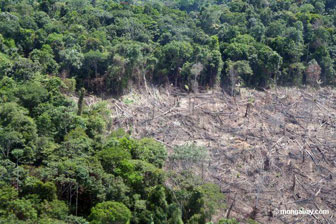Pre-Colombian Amazon rainforest not heavily populated suggests new study
Pre-Colombian Amazon rainforest not heavily populated
mongabay.com
March 6, 2007
Much of the Amazon rainforest was not heavily populated by pre-Colombian indigenous cultures argues a new paper published in the journal Philosophical Transactions of the Royal Society B: Biological Sciences. The work challenges an increasingly accepted theory — popularized in Charles C. Mann’s 1491: New Revelations of the Americas Before Columbus — that the Amazon supported dense, sedentary populations prior to the arrival of Europeans.
The theory — based on the discovery of a series of villages and a network of roads — suggests that much of the Amazon is “anthropogenic in nature” meaning that the distribution of forest species across the vast Amazon Basin has been influenced by mankind. It also holds that pre-Colombian populations suffered greatly from diseases introduced by Europeans, which may have wiped out 95-99 percent of the population within a century of “first-contact”. Abandoned settlements and agricultural areas would have been reclaimed by tropical rainforest. Since most structures would have been constructed of wood and bone which would not have lasted long in the hot and humid conditions of the Amazon, little archeological evidence would remain.
The new paper, authored by Dr. Mark Bush of the Florida Institute of Technology and colleagues, argues that while there may have been large populations living along the Amazon river, most of the rainforest had low population density and little of it could be considered “built” landscape. The conclusions are based on analysis of pollen and charcoal samples from upland forest areas in two lake districts in central and western Amazonia.
“We don’t contradict that there were major settlements in key areas flanking the Amazon Channel — there could have been millions of people living there,” said Bush. “What we do say is that when you start to look away from known settlements, you may see very long-term local use. These people didn’t stray very far from home, or from local bodies of water for several thousands of years. We looked at clusters of lakes and landscapes where people lived, and asked, did they leave their homesite to farm around other nearby lakes? No they didn’t. These findings argue for a very localized use of Amazonian forest resources outside the main, known, archaeological areas.”
The authors say their analysis indicate that the scale of human impacts in upland forest area, notably forest clearance and cultivation of maize and manioc, is “localized and probably strongly influenced by the presence of a permanent open-water body.”
Implications for Conservation

Product of mankind?
This certainly is.
So is this |
Bush argues that the findings should provide ammunition for conservation efforts in the Amazon since they seem to show that the rainforest, as we know it today, is not primarily a product of human actions and that to preserve biodiversity, it should be kept in a natural state.
“These data are directly relevant to the resilience of Amazonian conservation, as they do not support the contention that all of Amazonia is a ‘built landscape’ and therefore a product of past human land use,” Bush explained. “Most archaeologists are buying into the argument that you had big populations that transformed the landscape en masse. Another group of archaeologists say that transformation was very much limited to river corridors, and if you went away from the river corridors there wasn’t that much impact. That’s what our findings tend to support.”
Still, Bush believes the paper will only add fuel to debate over the historic impact of mankind on the Amazon forest.
“While the majority of archaeologists argue the rivers were the major conduit for populations, there is an increasing vocalization that there was much more widespread habitat transformation; that you still had a bulk of people along the river but their influence extended deep into the forest. It’s still nebulous, and difficult to get people to map stuff, or put hard numbers on it, but there is a sentiment that the Amazonia has been disturbed and that the view of the Amazonian rainforest as a built landscape is gaining momentum. There are extremes at either ends, and the majority of people are in middle but there’s a tendency of drifting toward the high end,” he said, noting that pre-Colombian population estimates for the Amazon have climbed from 1 million in the 1950s, to 4 millions in the 1970s, to 10 million in the 1990s, to the tens of millions by some today. “We’ve now got a polarized community,” he concluded.
CITATION: Mark B. Bush , Miles R. Silman Mauro B. de Toledo , Claudia Listopad, William D. Gosling , Christopher Williams , Paulo E. de Oliveira , Carolyn Krisel (2007). Holocene fire and occupation in Amazonia: records from two lake districts. Philosophical Transactions of the Royal Society B: Biological Sciences: Volume 362, Number 1478 / February 28, 2007
Related
Amazon Stonehenge suggests advanced ancient rainforest culture.
The discovery of an ancient astrological observatory in Brazil lends support to the theory that the Amazon rainforest was once home to advanced cultures and large sedentary populations of people. Besides the well-known empires of the Inca and their predecessors, millions of people once lived in the forests and shaped the environment to suit their own needs.
















